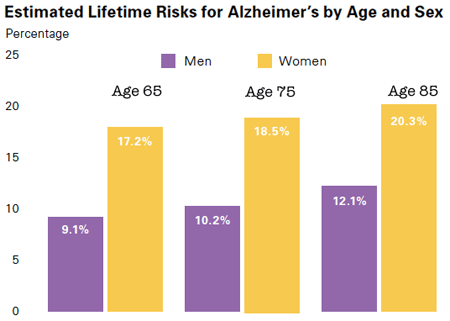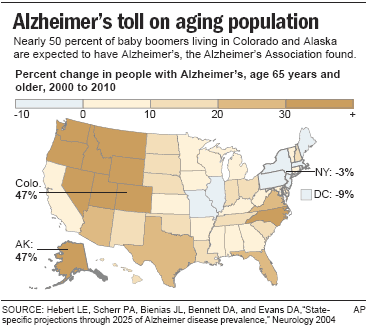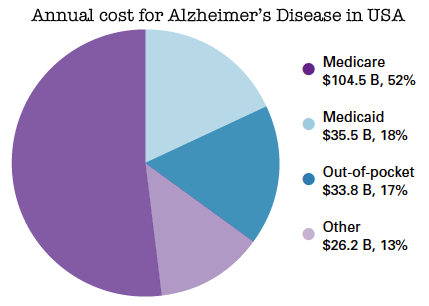
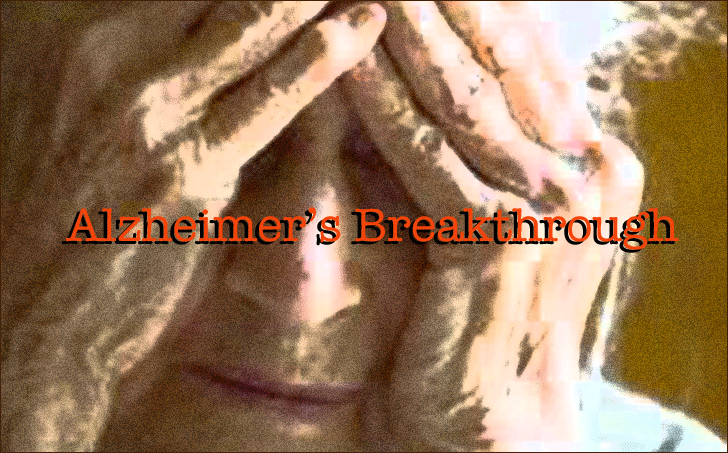
by Dan Eden for viewzone.com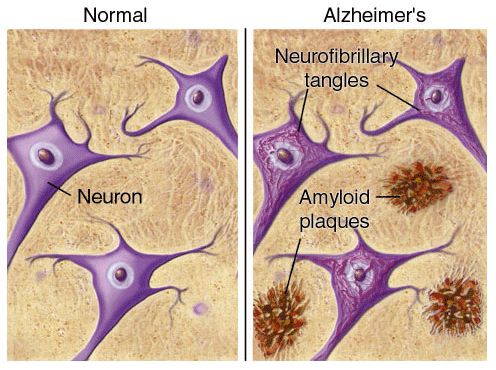


"Who are you? Do you work here?"
Despite all the care and attention my Dad gave her, Mom's Alzheimer's Disease eventually made it impossible to care for her at home. While it was painful to watch her deteriorate, we all loved her and were determined to keep close to her until the end. But soon she was a shell. The personality we had loved for decades faded from within and all contact was lost.
Towards the end of her life, Mom didn't recognize any of us and thought we were part of the nursing home staff. We continued to pay our respects to her physical body but it was clear that Alzheimer's had completely consumed the person we once called "Mom".
The pain and suffering of Alzheimer's Disease extends well beyond the individual victim. It is a prolonged illness that currently afflicts almost 6-million people in America and is projected to spike dramatically as "baby boomers" (i.e. people born right after WWII) reach old age.
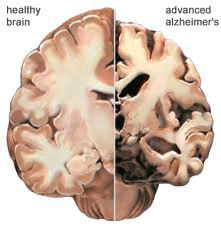 The current cost for Alzheimer's care exceeds 200-billion dollars annually. This figure will soon spike dramatically, taxing an already over-burdened health care system and further stressing an estimated 15-million unpaid caregivers, mostly family members, who provide around-the-clock assistance as the insidious dementia wreaks havoc to memory, language, logic, emotions and ultimately shuts down parts of the brain responsible for maintaining heart function and breathing.
The current cost for Alzheimer's care exceeds 200-billion dollars annually. This figure will soon spike dramatically, taxing an already over-burdened health care system and further stressing an estimated 15-million unpaid caregivers, mostly family members, who provide around-the-clock assistance as the insidious dementia wreaks havoc to memory, language, logic, emotions and ultimately shuts down parts of the brain responsible for maintaining heart function and breathing.
But there is now reason to be optimistic.
A new therapy, tested on laboratory mice, has successfully stopped the progression of Alzheimer's and has actually reversed the changes to the brain that are responsible for the dementia and eventual death associated with the disease.
Plaques and Tangles
It is likely that Alzheimer's Disease has been around for thousands of years. Only in the last few decades has the life expectancy increased beyond 40 years, bringing the disease to the forefront. Without modern support systems and treatments, it is likely that many victims of this type of dementia died from falls or other related accidents before the cause was known.

Alzheimer's Disease (AD) is still a mystery and treating it has mainly focused on the symptoms. For 30 years now it has been known that AD changes the structure of the brain, causing sticky plaques, tangled neurons and inflammation to accumulate. The disease takes a slow course, starting many years before any notable memory problems. Scientific research has been directed towards early detection and a myriad of medicines that attempt to slow the formation of the plaques and tangles. Although there has been modest progress in this regard, the disease remains lethal with no known treatment to reverse its course and repair the damage -- until now.
Aside from the plaques, researchers noted that AD brain tissue had unusually high deposits of aluminum, leading many to consider the disease as a kind of poisoning. While this is now largely disregarded, other abnormalities in the brain and spinal fluid hinted that the disease might be caused by a malfunction of the immune system. Specifically, there was an over abundance of an immune molecule called P-40 that is responsible for inflammation found in the fluid surrounding the brain.
Psoriasis and Multiple Sclerosis are known auto-immune diseases. In both of these diseases the body's immune system malfunctions and attacks healthy cells. In both diseases there is also an elevated level of P-40. Successful treatment inhibits specific proteins called interleukens (IL-12 and IL-23) that produce the P-40 by way of an introduced human anti-body, given by injection.
Called "ustekinumab" and marketed under the name Stelara (Contocor), this antibody has had dramatic results with over 80% of psoriasis victims reporting over 75% improvement in their skin. Trials for MS are expected to show similar results.
Would this work as well for victims of Alzheimer's Disease?
The Breakthrough Treatment
In Nature Medicine, November 2012, Prof. Frank Heppner from the Department of Neuropathology at Charité and his colleague Prof. Burkhard Becher from the Institute for Experimental Immunology at the University of Zurich found they could turn off the interleuken in the brains of mice with Alzheimer's Disease, reduce the production of P-40 and reduce the plaques by as much as 65%. They noted that the dementia symptoms also reversed.
Becher believes the findings that were confirmed in follow-up testing suggest clinical trials in humans are warranted. To be clear, researchers suspect the interleuken (IL-12 and IL-23) are not the cause of Alzheimer’s disease and they note further clarification of the role of P-40 in the AD process is needed. But to the millions of people who have or may soon be diagnosed with Alzheimer's Disease this is a dramatic breakthrough.
The mouse studies have taken place over the last 6 years, justifying the next step which would be to see if blocking P-40 could reverse Alzheimer’s symptoms in humans too.
|
Facts and Figures about Alzheimer's Disease
|
Use it or lose it
Alzheimer's Disease seems to effect some people more than others. People with a higher education, active social life and who continue to use their brains for work or personal growth seem to have less cognitive symptoms. The theory is that the brain, over time, develops many different pathways to memory and logic. These pathways form redundancy that seem able to survive the damage caused by the plaques and tangles.
In addition to medical treatment, exercises involving memory and logic have shown to benefit the survivability of this disease. About one in seven AD victims live alone or have limited social contact. This suggests that some type of community outreach could benefit those that are isolated.
UPDATE: 2013
Promising Compound Restores Memory Loss and Reverses Symptoms of Alzheimer's in Mice
Jan. 2, 2013 (ScienceDaily.com) — A new ray of hope has broken through the clouded outcomes associated with Alzheimer's disease. A new research report published in January 2013 print issue of the FASEB Journal by scientists from the National Institutes of Health shows that when a molecule called TFP5 is injected into mice with disease that is the equivalent of human Alzheimer's, symptoms are reversed and memory is restored -- without obvious toxic side effects.
"We hope that clinical trial studies in AD patients should yield an extended and a better quality of life as observed in mice upon TFP5 treatment," said Harish C. Pant, Ph.D., a senior researcher involved in the work from the Laboratory of Neurochemistry at the National Institute of Neurological Disorders at Stroke at the National Institutes of Health in Bethesda, MD. "Therefore, we suggest that TFP5 should be an effective therapeutic compound."
To make this discovery, Pant and colleagues used mice with a disease considered the equivalent of Alzheimer's. One set of these mice were injected with the small molecule TFP5, while the other was injected with saline as placebo. The mice, after a series of intraperitoneal injections of TFP5, displayed a substantial reduction in the various disease symptoms along with restoration of memory loss. In addition, the mice receiving TFP5 injections experienced no weight loss, neurological stress (anxiety) or signs of toxicity. The disease in the placebo mice, however, progressed normally as expected. TFP5 was derived from the regulator of a key brain enzyme, called Cdk5. The over activation of Cdk5 is implicated in the formation of plaques and tangles, the major hallmark of Alzheimer's disease.
"The next step is to find out if this molecule can have the same effects in people, and if not, to find out which molecule will," said Gerald Weissmann, M.D., Editor-in-Chief of the FASEB Journal. "Now that we know that we can target the basic molecular defects in Alzheimer's disease, we can hope for treatments far better -- and more specific -- than anything we have today."
Do you have an Alzheimer's story to share? We'd like to hear from you.


Reader's Comments:
Thanks for the good +hopeful+ news. I worked in a large metropolitan hospital for many years as a social worker. One of the saddest things for me was when an elderly couple would come in to the ER because the husband or wife had a fall and could not return home. Often the surviving member was in pretty good health, but their mate had to go in to a nursing home, leaving them alone and lonely. Because of the health care system, different needs of care are often in separate facilities, meaning the couple would never be together again. This is very sad especially when they have been together for 40 or 50 years.
The emotional pain and suffering that this brings is hard to watch. Often the non-Alzheimers member will literally die from lonliness, sometimes even before their AD affected mate.
Hopefully this new treatment will alleviate some of this pain.
BettyJ
Unless this treatment works as hoped there will likely be an age war between the young, who must pay taxes for Medicare, and the elderly, who will be viewed as burden to the younger citizens. We might even see euthanasia when an elderly person outlives their personality. Ouch!
Rmn143
For anyone suffering with this horrible disease right now there are some alternative medicines such as coconut oil. The medium tri-glycerides in coconut oil "feed" the brain cells more efficiently than normal metabolism in people with Alzheimers. There are lots of videos about this on YouTube. You should check it out.
DebH
I wonder how long it will take to get this drug approved for use in Alzheimers. According to your article, Stelara is already on the market for other uses. How much is this drug I wonder...
anonymous
Yeah. The annual cost of Stelara therapy is currently $33,600 for treating psoriasis! This will play into who gets it and if it is cost effective. Maybe it's time we had the government step in and make this and take the control and pricing away from the big pharmaceutical companies... like if we had a epidemic... and, actually, do we not have an epidemic with Alzheimers?
FreeBird22

